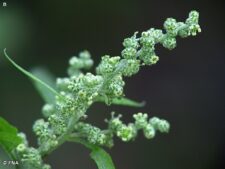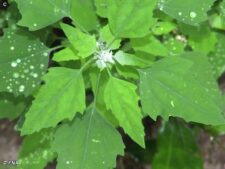
LAMB’S QUARTERS
Chenopodium album
GOOSEFOOT FAMILY (Chenopodiaceae)
 Identification
Identification
- Flowering time - June, July, August, September
- Uncommon in disturbed areas at FF and NW
- Coarsely toothed diamond-shaped or triangular leaves
- Densely packed greenish flower clusters
- Leaves often covered with mealy white material
This annual was probably introduced from Europe. It is now a common weed throughout Nebraska and grows up to 5 feet tall, but usually much shorter. The leaves are triangular or diamond-shaped, coarsely toothed and often covered with a mealy white powder (C). The inconspicuous flowers are tiny and have no petals, the greenish color coming from the fused sepals (calyx). They form round, densely packed spikes at the ends of the branched stems (A,B) producing large numbers of small, shiny black seeds.
In woodlands, roadside edges and waste places, flowering from June through September. It is uncommon in disturbed areas at both Fontenelle Forest and Neale Woods.
The cooked leaves are considered edible; some say they are as tasty as spinach. It is widely grown as a food plant in parts of Africa and Asia.
Goosefoot is a common name used for many members of this family, presumably a reference to the shape of the leaves. Another name, Bacon Weed, reflects its use as a food source.
The content of NatureSearch is provided by dedicated volunteer Naturalists of Fontenelle Forest who strive to provide the most accurate information available. Contributors of the images retain their copyrights. The point of contact for this page is: Roland Barth.


